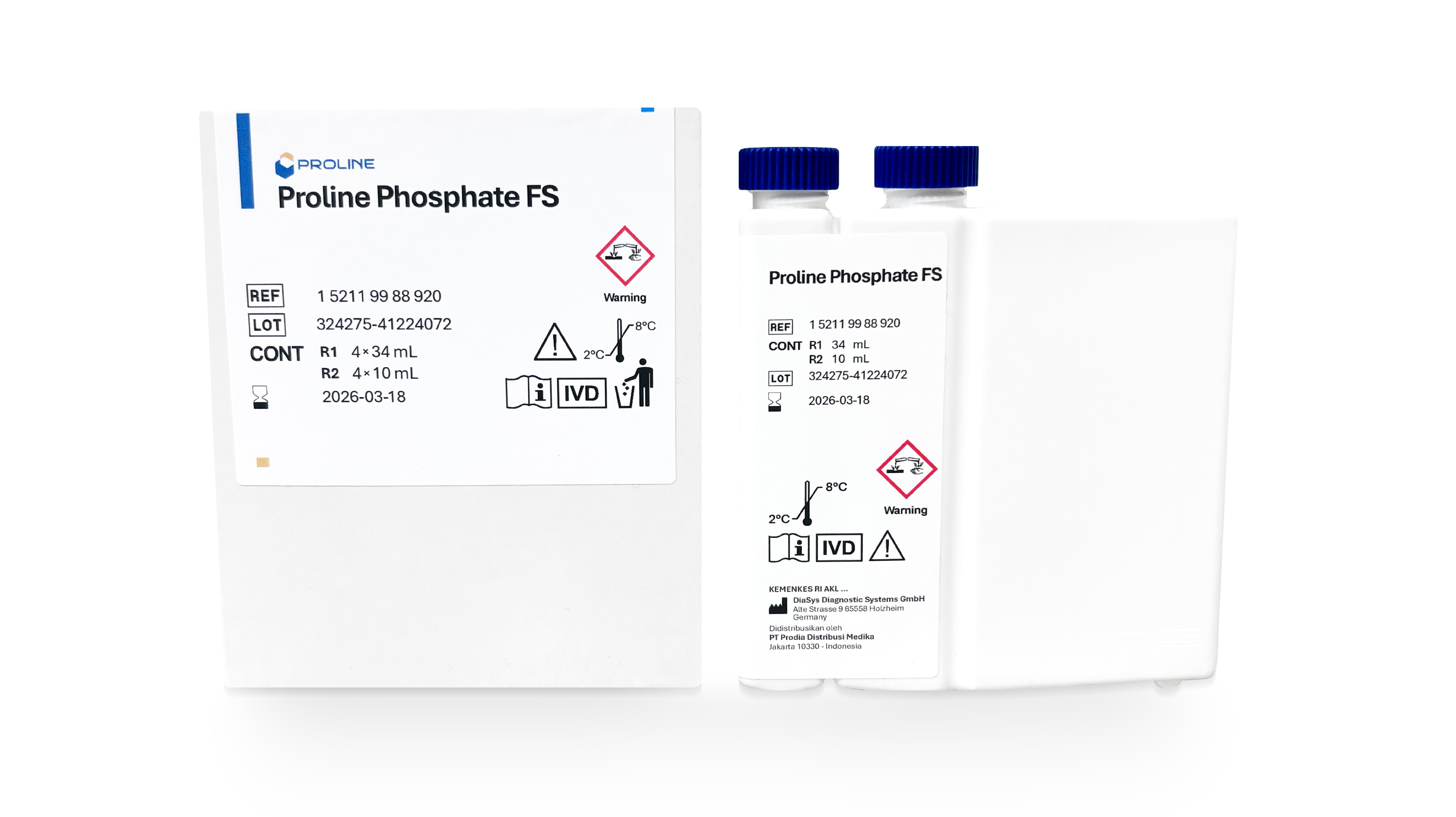Proline Phosphate FS

| Catalogue Number | R1 Reagent Volume | R2 Reagent Volume |
| 1 5211 99 88 920 | 4 x 34 mL | 4 x 10 mL |
| 1 5211 99 88 021 | 5 x 20 mL | 1 x 25 mL |
| 1 5211 99 88 930 | 4 x 20 mL | 2 x 20 mL |
Diagnostic reagent for the quantitative examination of phosphorus in serum or plasma in vitro by a photometric system.
Phosphorus exists in the body as phosphate, primarily as an inorganic component of bones, as well as within cells in the form of phospholipids, nucleic acids, and adenosine triphosphate, which is involved in energy transfer. Phosphate is one of the important electrolytes in the human body, making up about 1% of total body weight. In adults, the normal serum phosphate level ranges from 2.5 to 4.5 mg/dL.
In the body, phosphate plays several important roles:
- Bone Mineralization: Phosphate helps mineralize the bone matrix, forming hydroxyapatite crystals with calcium.
- Endochondral Ossification: Increased intracellular phosphate levels induce apoptosis of terminally differentiated chondrocytes.
- Teeth: Phosphate is important for the mineralization of all structural components of the tooth, i.e. the integral components of enamel, dentin, cementum, and alveolar bone.
- Cellular function: Phosphate in the cell is an essential component of the lipid layer of the cell membrane, DNA, RNA, and proteins. Phosphate is responsible for several enzymatic reactions in the cell, e.g. glycolysis and ammoniagenesis.
- Hemoglobin Function: Phosphate has a role in the oxygen-carrying capacity of hemoglobin by regulating the synthesis of 2,3-bisphosphoglycerate.
- Urinary Buffering: Inorganic phosphate acts as an effective buffer in urine by binding hydrogen ions, helping to maintain pH balance.
- Hypophosphatemia: Serum phosphate levels less than 2.5 mg/dL. It can be caused by decreased dietary intake (e.g., malabsorption, alcoholism, vitamin D deficiency), increased excretion (e.g., hyperparathyroidism, diuresis), or transcellular shifts (e.g., insulin treatment for diabetic ketoacidosis).
- Hyperphosphatemia: Serum phosphate levels greater than 4.5 mg/dL. It can be caused by acute phosphate load that can occur through exogenous (e.g., intake of phosphate-containing laxatives and vitamin D toxicity) or endogenous (e.g., tumor lysis syndrome and rhabdomyolysis) mechanisms, decreased phosphate excretion (e.g., renal failure, hypoparathyroidism, and pseudohypoparathyroidism), as well as transcellular shift from intracellular to extracellular fluid (e.g., diabetic ketoacidosis and lactic acidosis).
UV photometric test with endpoint determination.
- Ready-to-use liquid reagent (open-system) without reconstitution.
- Excellent linearity and stability performance.
- Available in MPK (Multi-Purpose Kit) and dedicated kit.
| Sample type | Serum, plasma heparin, or urine |
| Measurement range | 0.2 mg/dL - 30 mg/dL |
| Analysis wavelength | 340 nm, Hg 334 nm, Hg 365 nm, 660 nm bichromatic |
| Analysis mode | End point |
| Reagent volume used (analyzer manual) | R1: 800 µL ; R2: 200 µL |
| Sample volume used (analyzer manual) | 10 µL |
| Storage temperature | 2 – 8 °C |
| Open vial stability | 18 months |
| Expiration date | 24 months |
| Reference Range: | ||
| mg/dL | mmol/L | |
| Serum | ||
| Adult | 2.6 – 4.5 | 0.84 – 1.45 |
| Children/Adolescents | ||
| 1 – 30 day(s) | 3.9 – 7.7 | 1.25 – 2.50 |
| 1 – 12 month(s) | 3.5 – 6.6 | 1.15 – 2.15 |
| 1 – 3 years | 3.1 – 6.0 | 1.00 – 1.95 |
| 4 – 6 years | 3.3 – 5.6 | 1.05 – 1.80 |
| 7 – 9 years | 3,.0 – 5.4 | 0.95 – 1.75 |
| 10 – 12 years | 3.2 – 5.7 | 1.05 – 1.85 |
| 13 – 15 years | 2.9 – 5.1 | 0.95 – 1.65 |
| 16 -18 years | 2.7 – 4.9 | 0.85 – 1.60 |
| Plasma | 0.2 – 0.3 | 0.06 – 0.10 |
| Urine | 0.4 – 1.3 g/24 hours | 12.9 – 42.0 mmol/24 hours |
- Phosphate Reagent
- Doos
- Kit insert
- Reagents bottle
- Proline Phosphate FS Kit Insert (15211 01 – Mar 2024/00 ).
- Qadeer HA, Bashir K. Physiology, Phosphate. [Updated 2023 Aug 28]. In: StatPearls [Internet]. Treasure Island (FL): StatPearls Publishing; 2025 Jan-. Available from: https://www.ncbi.nlm.nih.gov/books/NBK560925/
- Brochure : INA
- Kidney disease
- Bone Metabolism
Contact our team to find out more product information and ordering
- Telp : +62 21 8984 2722
- WhatsApp : +62 815 1359 2626
- Email : marketing@proline.co.id
Contact our Technical support team for further assistance with product specifications, services and other technical documents.
- Telp : +62-21-8984-2722
- WhatsApp : +62-817-9324-884
- Email : technical.support@prodis.co.id
